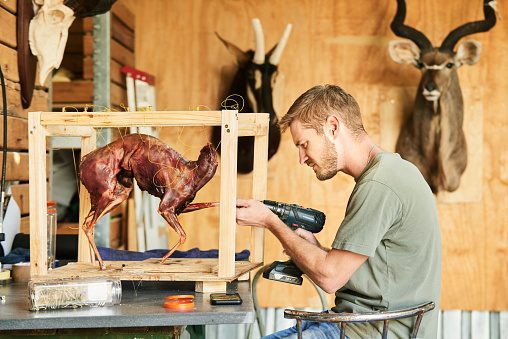| Taxidermist Key Stats | |
|---|---|
| Education | 0-6 Months |
| Job Outlook | 0% |
Taxidermists are professionals who are experienced in creating trophies and mementos using the remains of a deceased animal.
These professionals are able to work with an array of animal carcasses to create lifelike trophies for individuals to use as a memento or for use in a museum.
These individuals may create trophies for clients for a variety of reasons.
Some individuals may want Taxidermists to memorialize their pets, as memorabilia for a successful hunting trip or for décor that fits a room’s style.
Individuals who want to become a Taxidermist will need a combination of hands on experience, some training, licensure and certification and several personal characteristics that will help them become successful in this field.
Some helpful skills include: dexterity to work carcasses, attention to detail and some artistic ability to mimic life in a deceased animal.
Go to Page Section:
Education Requirements to Become a Taxidermist
Individuals who want to become a Taxidermist will need to develop their taxidermy skills by gaining hands on experience or completing a certification program.
Taxidermists will need to know animal biology and secure certification as a Taxidermist.
In addition, Taxidermists will need to secure a license and state permit in order to practice taxidermy.
Individuals may seek an apprenticeship that will help them gain the skills to become a Taxidermist.
Apprenticeships are paid jobs typically at the entry level in which an individual will learn their chosen trade under the supervision of a seasoned professional.
Under an apprenticeship, individuals will learn the necessary skills in order to work in their chosen career path.
Individuals who want to become a Taxidermist also have the option to complete a certification program through an accredited trade school or community college in order to enter this profession.
Through these programs, individuals will take artistic and technical classes that will help them prepare for a career in Taxidermy.
Common topics in these courses include the use of tools, taxidermy regulations and techniques that help preserve animal carcasses.
Some additional skills include understanding the many different types of animals, animal form and the coloring and texturing of animal furs and feathers.
Licensure and certification will depend on the state an individual resides in.
Individuals are encouraged to contact their state for specific requirements.
Taxidermist Job Description
Taxidermists are professionals who are experienced in taking an animal carcass and using a variety of techniques that will help with its preservation.
The reason for preserving an animal carcass can vary and will depend on the client who places an order.
These individuals may work full time creating a variety of animal statutes including for artistic, science, trophies or mementos.
The following are some Taxidermy techniques used to preserve carcasses:
- Tanning
- Stuffing
- Mounting
- Retouching
Some common types of animals individuals like to preserve include: Moose, large game, small mammals, birds and fish.
Taxidermist Salary and Career Path
Exact wages for professionals who work in taxidermy will vary per individual.
There are a lot of factors that contribute to a Taxidermist’s exact yearly wages.
Some factors contributing to one’s income include years of experience, professional reputation, number of clients and geographical location.
In 2012, the average yearly salary for Taxidermists was approximately $31,000 per year.
However, this average includes professionals who work on a part time basis.
The average yearly wage for Taxidermists who work part time is between $10,000 and $20,000 while those who work full time can earn between $40,000 and $50,000 per year.
There are no exact details for the job outlook for the Taxidermist profession although some consider the outlook to be good meaning there is some expected job growth.
Professionals seeking a job within the arts such as in a museum will have tougher job prospects because of the limited openings and stiff competition.
Taxidermists who seek to create trophies for fishers or hunters have stronger job prospects.
Taxidermists are professionals who take an animal carcass and use a variety of techniques to preserve it for display purposes.
These individuals may create these animal displays for a variety of reasons including as mementos for those who have lost their dear pet or for hunters who would like a trophy as a reminder of their experience.
These professionals have a variety of options when seeking jobs including contracting work or securing a position at a museum.
Frequently Asked Questions
What is a taxidermist?
A taxidermist is someone who is specialized in preserving an animal’s body through mounting or stuffing.
Taxidermists determine their client’s preferences, measure the specimen that needs to be taxidermied and prepare the body for the procedure by removing, preserving and disinfecting the skin.
They also have to construct the mount, which will serve as the foundation and will be covered by the specimen’s new skin.
Taxidermists also construct artificial body parts, such as eye and tongues and attach them to the body.
Taxidermists use salt, alkaline solutions or other chemicals to tan the skin.
The final step is to sew the animal’s skin over the constructed mount and getting the mount ready for display by reconstructing the animal’s fauna.
As a taxidermist, you will need a very good knowledge of animal anatomy and an artistic eye but also patience and good communication skills.
How much does a taxidermist make?
The answer to this question depends on the amount of time you devote to taxidermy.
If you want to practice it part-time you may make less than $20,000 per year but if you’re a determined full-time taxidermist you can make more than $100,000 a year.
How much does it cost to become a taxidermist?
There are several post-secondary programs that can teach you the skills needed to perform this job.
During the training period, you will also get the chance to start building your portfolio.
Costs for training programs range from $2,500 to $20,000, depending on the school and the program duration.
Most states require taxidermists to be licensed so if you want to start a career in this field you should first check out the local laws.
Some employers and clients may prefer candidates who have been certified by the National Taxidermists Association.
What is the demand for taxidermists?
The Bureau of Labor Statistics doesn’t record data about taxidermists; your success and work opportunities as a taxidermist depend on your determination, skills, and portfolio.
It is also essential that you promote your work, through social media or by finding local businesses where you can display your work.
How long does it take to become a taxidermist?
You can learn the skills needed to practice taxidermy through training programs that can be completed in a few weeks or a few months or through an apprenticeship.
Taxidermy schools typically offer programs that include many hours of hands-on training and give students the opportunity to start building a portfolio.
However, learning the technical skills needed for this job is just the first step; to be able to practice taxidermy you will also need a state license.
Taxidermy laws vary by region and state and you should check the local laws before starting to build a career in this field.
After getting your license you’re ready to start building a client base by promoting your work.











